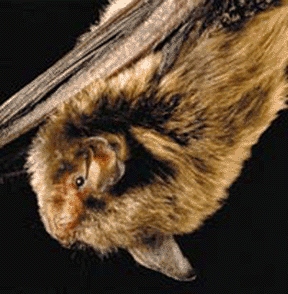What is the maximal age a Indiana bat reaches?
An adult Indiana bat (Myotis sodalis) usually gets as old as 20 years.
When born, they weight 4 grams (0.01 lbs) and measure 0.9 cm (0′ 1″). As a member of the Vespertilionidae family (genus: Myotis), a Indiana bat caries out around 1 little ones per pregnancy, which happens around 1 times a year. Fully grown, they reach a bodylength of 4.7 cm (0′ 2″).
As a reference: Usually, humans get as old as 100 years, with the average being around 75 years. After being carried in the belly of their mother for 280 days (40 weeks), they grow to an average size of 1.65m (5′ 5″) and weight in at 62 kg (137 lbs), which is obviously highly individual.

The Indiana bat (Myotis sodalis) is a medium-sized mouse-eared bat native to North America. It lives primarily in Southern and Midwestern U.S. states and is listed as an endangered species. The Indiana bat is gray, black, or chestnut in color and is 1.2–2.0 in long and weighs 4.5–9.5 g (0.16–0.34 oz). It is similar in appearance to the more common little brown bat, but is distinguished by its feet size, toe hair length, pink lips, and a keel on the calcar.Indiana bats live in hardwood and hardwood-pine forests. It is common in old-growth forest and in agricultural land, mainly in forest, crop fields, and grasslands. As an insectivore, the bat eats both terrestrial and aquatic flying insects, such as moths, beetles, mosquitoes, and midges.The Indiana bat is listed as an endangered species by the U.S. Fish and Wildlife Service. It has had serious population decline, estimated to be more than 50% over the past 10 years, based on direct observation and a decline on its extent of occurrence.
Animals of the same family as a Indiana bat
Not really brothers and sisters, but from the same biological family (Vespertilionidae):
- Yellowish myotis bringing the scale to 5 grams
- Hairy-legged myotis bringing the scale to 5 grams
- Tacarcuna bat bringing the scale to 12 grams
- Eastern false pipistrelle bringing the scale to 22 grams
- Chocolate wattled bat with 1 babies per pregnancy
- Spotted bat with 1 babies per pregnancy
- Large myotis bringing the scale to 42 grams
- Heller’s pipistrelle bringing the scale to 3 grams
- Zulu serotine bringing the scale to 4 grams
- Lesser noctule with 1 babies per pregnancy
Animals that reach the same age as Indiana bat
With an average age of 20 years, Indiana bat are in good companionship of the following animals:
- European rabbit usually reaching 18 years
- European badger usually reaching 16.17 years
- Greater mouse-eared bat usually reaching 22 years
- Matschie’s tree-kangaroo usually reaching 23.83 years
- Koala usually reaching 20 years
- Yellow-backed duiker usually reaching 17.25 years
- Guadalupe fur seal usually reaching 24 years
- False killer whale usually reaching 22 years
- Bennett’s tree-kangaroo usually reaching 20 years
- Sitatunga usually reaching 21.5 years
Animals with the same number of babies Indiana bat
The same number of babies at once (1) are born by:
- Prince Demidoff’s bushbaby
- Celebes crested macaque
- Rüppell’s broad-nosed bat
- Beluga whale
- Small dorcopsis
- Kitti’s hog-nosed bat
- Eastern white-eared giant rat
- Woermann’s bat
- Rafinesque’s big-eared bat
- Sugar glider
Weighting as much as Indiana bat
A fully grown Indiana bat reaches around 7 grams (0.02 lbs). So do these animals:
- Broad-headed pipistrelle with 6 grams
- Long-legged myotis with 8 grams
- Jackson’s shrew with 7 grams
- Eastern harvest mouse with 8 grams
- Hairy slit-faced bat with 7 grams
- Lesser long-tongued bat with 8 grams
- Rufous mouse-eared bat with 7 grams
- Thomas’s nectar bat with 7 grams
- Thomas’s horseshoe bat with 8 grams
- Rüppell’s pipistrelle with 7 grams
Animals as big as a Indiana bat
Those animals grow as big as a Indiana bat:
- Woermann’s bat with 4 cm (0′ 2″)
- Wagner’s mustached bat with 4.5 cm (0′ 2″)
- Moupin pika with 5.2 cm (0′ 3″)
- Egyptian slit-faced bat with 5.2 cm (0′ 3″)
- Mexican free-tailed bat with 4.1 cm (0′ 2″)
- Rufous trident bat with 4.4 cm (0′ 2″)
- Inyo shrew with 5.2 cm (0′ 3″)
- Fringed myotis with 5.2 cm (0′ 3″)
- Daubenton’s bat with 4.4 cm (0′ 2″)
- Lesser horseshoe bat with 3.8 cm (0′ 2″)
